Lifestyle
On a warming planet, scientists eager to learn more about how bees cope
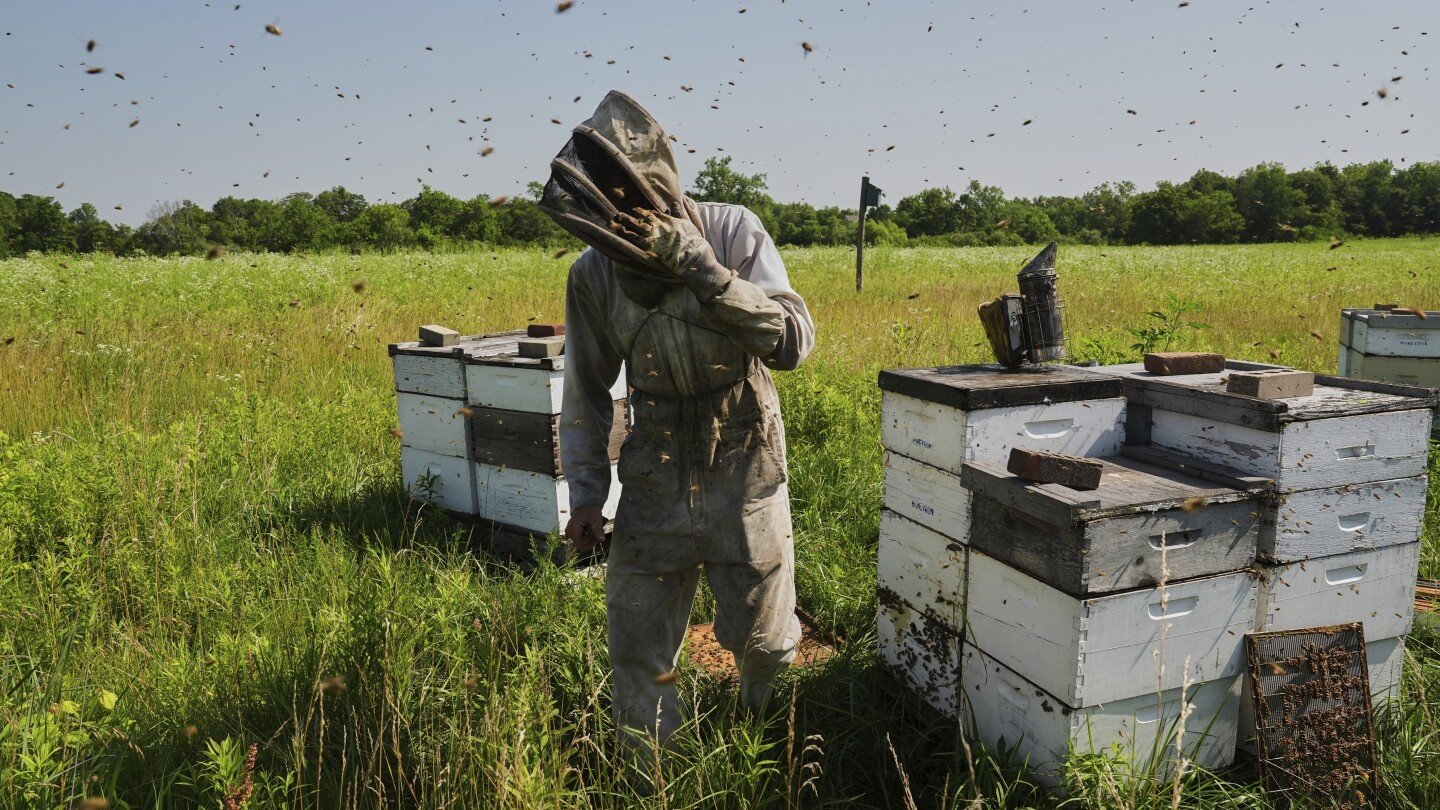
WILLIAMSPORT, Ohio (AP) — Sweat covers Isaac Barnes’s face under his beekeeper’s veil as he hauls boxes of honeycomb from his hives to his truck. It’s a workout in what feels like a sauna as the late-morning June temperatures rise.
Though Barnes was hot, his bees were even hotter. Their body temperatures can be up to 27 degrees Fahrenheit (about 15 Celsius) higher than the air around them. As global temperatures rise under climate change, scientists are trying to better understand the effects on managed and wild bees as they pollinate crops, gather nectar, make honey and reproduce.
Isaac Barnes inspects a honeycomb from one of his honeybee hives Tuesday, June 24, 2025, in Williamsport, Ohio. (AP Photo/Joshua A. Bickel)
Isaac Barnes takes a drink of water after harvesting honeycomb from his honeybee hives Tuesday, June 24, 2025, in Williamsport, Ohio. (AP Photo/Joshua A. Bickel)
They noticed flying bees gathering nectar avoided overheating on the hottest days by using fewer but harder wingbeats to keep their body temperature below dangerous levels, according to a study published last year. Scientists also say that bees — like people — may also cope by retreating to a cooler environment such as the shade or their nest.
“Just like we go into the shade, or we sweat or we might work less hard, bees actually do the exact same thing so they can avoid the heat,” said Jon Harrison, an environmental physiologist at Arizona State University and one of the study’s authors.
But that means the bees aren’t able to do what they normally do, said Kevin McCluney, a biology professor at Bowling Green State University.
“They’re not going out and getting more nectar. They’re not mating. They’re not doing the things that bees would otherwise do,” McCluney said.
Heat is just one challenge for critical pollinator
Kevin McCluney, a biology professor, looks for bees to collect Tuesday, June 17, 2025, at Bowling Green State University in Bowling Green, Ohio. (AP Photo/Joshua A. Bickel)
Generally, most bees are heat-tolerant, but as the climate warms, some experts think their ability to fend off disease and gather food might become harder. And habitat loss, increased use of pesticides, diseases and lack of forage for both managed and wild bees are all listed as potential contributors to the global decline of bees and other pollinators.
“If you’re not well-fed, and your body is intoxicated with pesticides and you have lots of diseases in your body, you’re going to be less heat-tolerant than if you were healthy,” said Margarita López-Uribe, a pollinator health expert at Pennsylvania State University.
Scientists have found that bees may cope with heat the same way humans do — by finding a cooler environment. But they aren’t able to do as much as they normally do, and scientists worry that heat makes the bees more vulnerable to disease and plant diversity could decline due to less pollination. (AP Video: Joshua A. Bickel)
Earlier this year, preliminary results from the annual U.S. Beekeeping Survey found that beekeepers lost almost 56% of their managed colonies, the highest loss since the survey started in 2010.
Almost all of the managed honeybee colonies in the U.S. are used to pollinate agricultural crops such as almonds, apples, cherries and blueberries. Fewer pollinators can lead to less pollination and potentially lower yields.
“It’s a very fragile system if you think about it,” López-Uribe said. “Because if something goes wrong, you have these super high-value crops that won’t get enough bees for pollination.”
Losing hives at Honeyrun Farms
Back at Barnes’ hives in Ohio, thousands of honeybees fly around as he gathers boxes to take back to his farm for honey production. Nearby, a couple of his bees land on milkweed flowers, a rare bit of plant diversity in an area dominated by corn and soybean fields.
For Barnes, who operates Honeyrun Farm with his wife, Jayne, one of the challenges heat can pose to his 500 honeybee hives is fending off parasitic mites that threaten the bees. If temperatures get too hot, he can’t apply formic acid, an organic chemical that kills the mites. If it’s applied when it’s too hot, the bees could die.
As global temperatures rise under climate change, bees that pollinate many crops are under increasing stress. For Ohio beekeeper Isaac Barnes, heat can affect his bee colonies’ health into the winter just before crop pollination begins. In the U.S., beekeepers lost just over half of their colonies in the last year. (AP Video: Joshua A. Bickel)
Last year they lost almost a third of the 400 hives they sent to California to help pollinate commercial almond groves. Barnes thinks those hives may have been in poor health ahead of pollination because they were unable to ward off mites when it was hot months earlier.
“Dead hives aren’t pollinating the almonds,” he said. “It’s a real ripple effect that stems back from the heat in the summertime.”
Sometimes the heat helps. Here in Ohio, Barnes’ hives last summer produced a bumper crop of honey as they feasted on nearby soybean nectar as the plants bloomed in the heat. Still, the lack of diverse plants for bees to forage in an area dominated by corn and soybean fields isn’t ideal.
An employee scrapes raw honey off of a honeycomb while working Tuesday, June 24, 2025, at Honeyrun Farm in Williamsport, Ohio. (AP Photo/Joshua A. Bickel)
And even the native blooms are appearing erratically, Barnes said. In autumn, his bees search for food on goldenrod, but those blooms are appearing later. And even then, he has supplemented his hive with additional food to keep them healthy into the winter.
“Every single plant that blooms is something that the bee can use,” Barnes said. “And every single plant is affected by climate change.”
Research that may aid bees is in peril
It’s only in the last decade that people have become aware of the magnitude of the pollinator decline globally, said Harrison, of Arizona State University. Data is limited on how much climate change and heat stress is contributing to pollinator decline.
“It’s a relatively new focus for biology,” he said. “I think it’s super important, but it’s not being studied a ton.”
Reese Jackson holds a leafcutter bee inside of a collection vial Tuesday, June 17, 2025, at Bowling Greene State University in Bowling Green, Ohio. (AP Photo/Joshua A. Bickel)
The Trump administration’s proposed budget would eliminate the research program that funds the USGS Bee Lab, which supports the inventory, monitoring and natural history of the nation’s wild bees. Other grants for bee research are also in jeopardy.
U.S. Sen. Jeff Merkley of Oregon said America’s pollinators are in “grave danger,” and he’ll fight for the federal funding. Pollinators contribute to the health of the planet, the crops we grow and the food we eat, he said.
“Rather than taking bold action to protect them, the Trump administration has proposed a reckless budget that would zero out funding for critical research aimed at saving important pollinators,” he said in a statement to The Associated Press.
A bee-shaped sticker sits on a truck window Tuesday, June 24, 2025, in Williamsport, Ohio. (AP Photo/Joshua A. Bickel)
Harrison said his research on this topic would come to a halt if cuts are made to his federal funding, and it would be more difficult in general for scientists to study the disappearance of bees and other pollinators and improve how they prevent these losses. Not being able to manage these pollinator deaths could cause the price of fruits, vegetables, nuts, coffee and chocolate to jump or become scarce.
“Hopefully, even if such research is defunded in the U.S., such research will continue in Europe and China, preventing these extreme scenarios,” said Harrison.
___
The Associated Press’ climate and environmental coverage receives financial support from multiple private foundations. AP is solely responsible for all content. Find AP’s standards for working with philanthropies, a list of supporters and funded coverage areas at AP.org.
Lifestyle
A clash over men’s beachwear divides Algerian town of Chetaibi
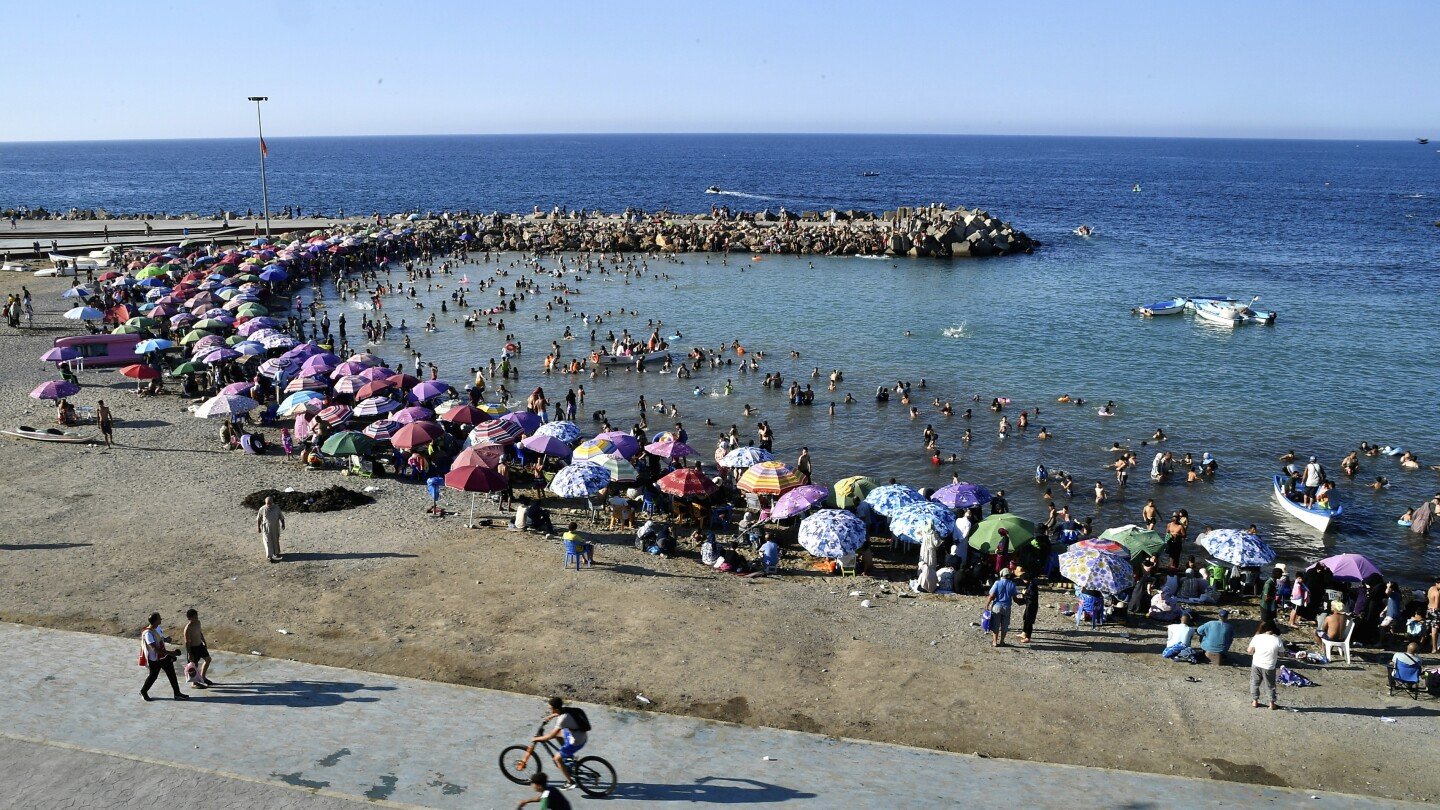
CHETAIBI, Algeria (AP) — A scenic beach town on Algeria’s Mediterranean coastline has become the center of a clash over men’s bathing suits, pitting religious and conservative values against tourist habits.
Chetaïbi, a town of 8,000 known for its turquoise waters, rocky coves, and forested hills, draws thousands of Algerian beachgoers each summer. Seasonal tourism is a cornerstone of the local economy.
“The mood is warm, welcoming, colorful, bustling — no hostility toward bathers, not in words, not in looks. People here have a tradition of hospitality,” said Salah Edine Bey, a longtime resident.
In his view, there was little sign of controversy, until there was.
Earlier this month, some vacationers and business owners were caught off guard when the town’s mayor issued a decree banning beachgoers from walking around in Bermuda shorts, calling the attire indecent in contrast to the longer, looser shorts preferred by conservative male beachgoers.
“These summer outfits disturb the population, they go against our society’s moral values and sense of decency,” Mayor Layachi Allaoua wrote.
“The population can no longer tolerate seeing foreigners wandering the streets in indecent clothing,” he added, referencing visitors from elsewhere in Algeria.
The order sparked immediate backlash from officials, including in the regional capital Annaba, who called on the mayor to revoke it.
The mayor reversed the decree within two days. On Facebook, he insisted his order wasn’t driven by Islamist pressure, but by a desire to preserve “peace and tranquility” for both residents and guests.
Still, the episode tapped into deeper tensions over religion, identity, and public space in a country that remains haunted by a civil war that killed an estimated 200,000 people throughout the 1990s. The conflict began in 1991, when the army canceled elections that an Islamist party was set to win.
The so-called “black decade” ended long ago. But it left unresolved some underlying friction between political Islam and Algeria’s military-backed secular state.
“Even though Islamists lost the war in the 1990s, they never gave up on their invasive and intrusive ideological project, which has gained ground in society,” said sociologist Redouane Boudjemaâ.
For some, the beach debate echoed that earlier era, when Islamist-run municipalities tried to reshape public life in line with religious doctrine. For many Algerians, particularly in underserved regions, political Islam remains popular not out of extremism, but as a reaction to corruption, inequality, and distrust in state institutions. While Islamist parties have mostly fared poorly at the ballot box, they play a large role in daily life, filling social and moral voids.
In neighboring Jijel, residents have roped off parts of the beach for mass prayers, with videos of the scenes circulating online and dividing opinion.
For Halim Kabir, it’s a stark reminder of the past. In the 1990s, Islamists who won local elections in Jijel imposed stricter rules on public behavior. Today, cars parked near the beach have been vandalized with warnings telling beachgoers to “go sin elsewhere.”
“It’s provocation,” Kabir said. “An attempt to drive away visitors from other regions.”
Said Boukhlifa, a former senior official at the Ministry of Tourism, warned that conservative groups are exploiting Algeria’s economic troubles, as falling gas revenues strain the state, to expand their influence. That, he said, could undermine the country’s ambitions to grow its tourism sector.
Lifestyle
These tips from experts can help your teenager navigate AI companions

As artificial intelligence technology becomes part of daily life, adolescents are turning to chatbots for advice, guidance and conversation. The appeal is clear: Chatbots are patient, never judgmental, supportive and always available.
That worries experts who say the booming AI industry is largely unregulated and that many parents have no idea about how their kids are using AI tools or the extent of personal information they are sharing with chatbots.
New research shows more than 70% of American teenagers have used AI companions and more than half converse with them regularly. The study by Common Sense Media focused on “AI companions,” like Character. AI, Nomi and Replika, which it defines as “digital friends or characters you can text or talk with whenever you want,” versus AI assistants or tools like ChatGPT, though it notes they can be used the same way.
It’s important that parents understand the technology. Experts suggest some things parents can do to help protect their kids:
— Start a conversation, without judgment, says Michael Robb, head researcher at Common Sense Media. Approach your teen with curiosity and basic questions: “Have you heard of AI companions?” “Do you use apps that talk to you like a friend?” Listen and understand what appeals to your teen before being dismissive or saying you’re worried about it.
— Help teens recognize that AI companions are programmed to be agreeable and validating. Explain that’s not how real relationships work and that real friends with their own points of view can help navigate difficult situations in ways that AI companions cannot.
This article is part of AP’s Be Well coverage, focusing on wellness, fitness, diet and mental health. Read more Be Well.
“One of the things that’s really concerning is not only what’s happening on screen but how much time it’s taking kids away from relationships in real life,” says Mitch Prinstein, chief of psychology at the American Psychological Association. “We need to teach kids that this is a form of entertainment. It’s not real, and it’s really important they distinguish it from reality and should not have it replace relationships in your actual life.”
The APA recently put out a health advisory on AI and adolescent well-being, and tips for parents.
— Parents should watch for signs of unhealthy attachments.
“If your teen is preferring AI interactions over real relationships or spending hours talking to AI companions, or showing that they are becoming emotionally distressed when separated from them — those are patterns that suggest AI companions might be replacing rather than complementing human connection,” Robb says.
— Parents can set rules about AI use, just like they do for screen time and social media. Have discussions about when and how AI tools can and cannot be used. Many AI companions are designed for adult use and can mimic romantic, intimate and role-playing scenarios.
While AI companions may feel supportive, children should understand the tools are not equipped to handle a real crisis or provide genuine mental health support. If kids are struggling with depression, anxiety, loneliness, an eating disorder or other mental health challenges, they need human support — whether it is family, friends or a mental health professional.
— Get informed. The more parents know about AI, the better. “I don’t think people quite get what AI can do, how many teens are using it and why it’s starting to get a little scary,” says Prinstein, one of many experts calling for regulations to ensure safety guardrails for children. “A lot of us throw our hands up and say, ‘I don’t know what this is!’ This sounds crazy!’ Unfortunately, that tells kids if you have a problem with this, don’t come to me because I am going to diminish it and belittle it.”
Older teenagers have advice, too, for parents and kids. Banning AI tools is not a solution because the technology is becoming ubiquitous, says Ganesh Nair, 18.
“Trying not to use AI is like trying to not use social media today. It is too ingrained in everything we do,” says Nair, who is trying to step back from using AI companions after seeing them affect real-life friendships in his high school. “The best way you can try to regulate it is to embrace being challenged.”
“Anything that is difficult, AI can make easy. But that is a problem,” says Nair. “Actively seek out challenges, whether academic or personal. If you fall for the idea that easier is better, then you are the most vulnerable to being absorbed into this newly artificial world.”
___
The Associated Press’ education coverage receives financial support from multiple private foundations. AP is solely responsible for all content. Find AP’s standards for working with philanthropies, a list of supporters and funded coverage areas at AP.org.
Lifestyle
How to cook delicious meals in a vacation rental house
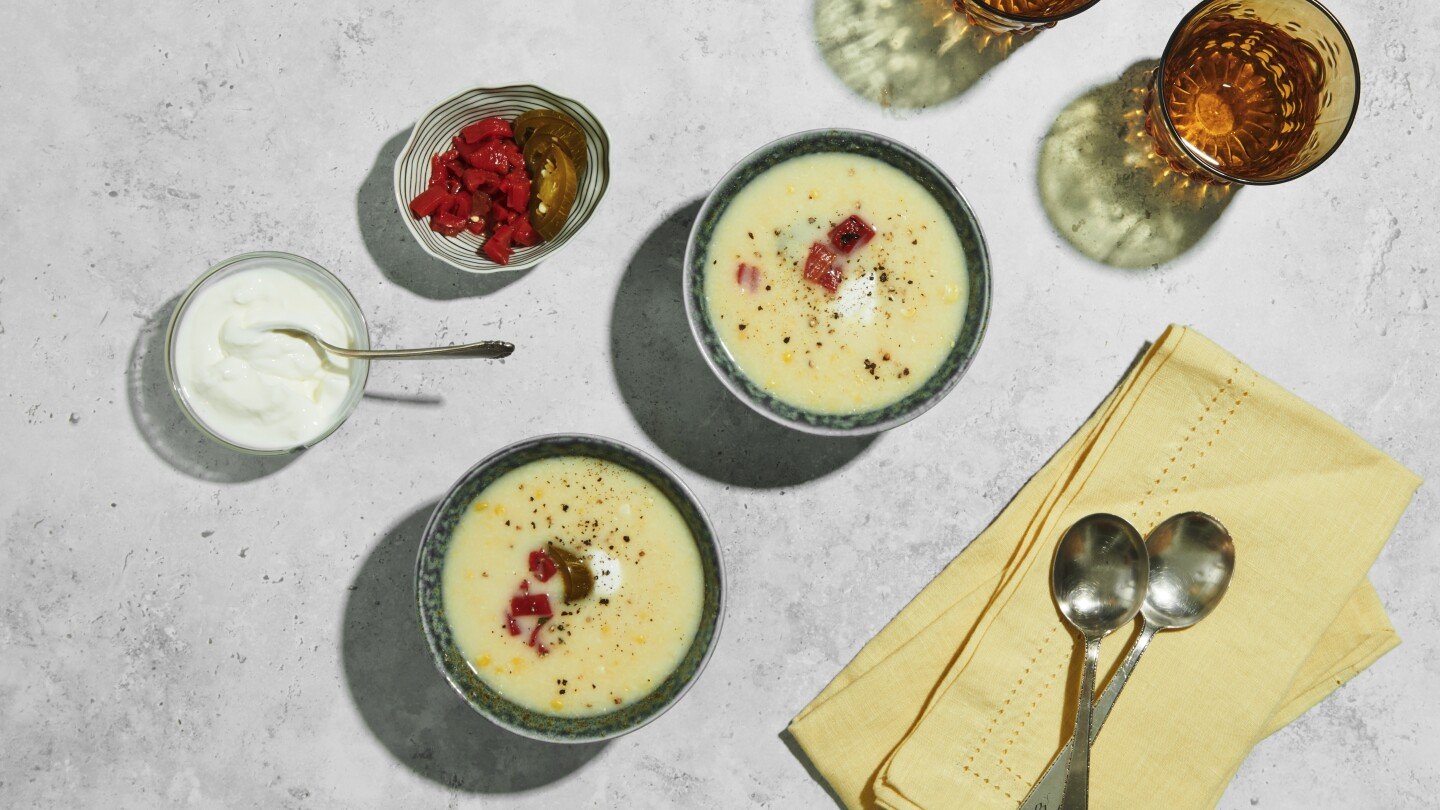
We are officially in the thick of summer. If we’re lucky, we might get a break from the routine and head for the beach, the mountains or maybe discover a new city.
For many, that means renting a vacation home — with an unfamiliar kitchen.
At home, you probably have a variety of cooking utensils, a meaningful collection of herbs and spices, and the ability to select just the right pan for your dish. But as you step into your Airbnb or Vrbo, you’re suddenly left wondering where to even put your groceries.
There’s a weird pleasure (at least for nerds like me) in pulling together a meal in a sparse, funky rental-house kitchen. It’s like a reality cooking show challenge. Can you make an omelet in a saucepan? Perhaps you don’t have fresh oregano … maybe those parsley stems will work? Can you stretch that small bottle of olive oil through the last two days of your trip? I’ll call that conundrum, and I’ll raise you a half a jar of gherkins.
During rental home vacations, it’s kind of fun to be untethered from the normal cooking routine. Believe you me, I’m racing out for fried clams at the local seafood joint as many nights as my budget and waistband allow. But for the meals I’m cooking, I’m relinquishing notions of perfection in favor of scrappiness.
Picked up a whole lot of cherry tomatoes at a farmstand? You’re making cherry tomato antipasti salad with some canned artichoke hearts, olives, onions and a quick vinaigrette. Maybe throw in some cubed provolone or diced salami. Peaches getting a bit too soft? Time for a smoothie.
There’s something liberating — and a little bit ridiculous — about cooking in a vacation rental kitchen.
Bring some essentials of your own
Before you go, consider packing a minimalist “kitchen survival kit.” It doesn’t have to be much: A sharp knife, a cutting board, salt and pepper, and whatever pantry staples you know you’ll need to get started.
For me, I might pack olive oil, vinegar, lemons, Dijon mustard and a couple of my favorite herbs and spices. I also always bring zipper-top bags and some small containers for leftovers or taking food on the go.
Use the rental’s features (and lack thereof) to your advantage
Think about dishes that can stretch ingredients, and about welcome substitutions. A big grain salad — made with rice, quinoa or couscous — is endlessly customizable and can be served cold or at room temperature (think lakeside lunch or a backyard meal).
I would also start with things that don’t require an oven — you never know if it heats unevenly, or at all (it might be a glorified bread box). A stovetop pasta tossed with sauteed garlic and olive oil is always a win. Add red pepper flakes and grated Parmesan if you have it.
Grills are often available and can be a vacation cook’s best friend — as long as you’ve got an ample supply of the right fuel for it. Grill up simply seasoned chicken breasts or New York Strip steaks for dinner and very intentionally make extra — those leftovers will be perfect sliced and used for sandwiches, quesadillas, salads or wraps. Extra grilled corn might become a corn soup or chowder, a corn salad or something to add to a stir-fry.
Think about brushing some slices of country bread with olive oil, sprinkling with flaky salt and toasting them lightly on the grill. Top with fresh sliced or chopped tomatoes with some basil, or turn them into whatever type of bruschetta you can whip up from your farmstand haul. Think caponata, sauteed chard or maybe a heap of sliced grilled peppers with some fresh goat cheese.
Salads are always on the docket. Again, easy to improvise with farmers market ingredients. But this is your vacation, and you should feel free to play. Try a melon and cucumber salad with a bit of feta and a squeeze of lime juice, or a chopped vegetable salad bolstered with protein-packed chickpeas.
Think creatively and accept imperfection
As you come to the end of your trip and you need to use things up, get creative. That half jar of pickles will add a briny punch to a potato salad. That nub of leftover cheese and that last bunch of spinach will be great chopped up and added to scrambled eggs or a frittata.
Cook what feels manageable, what makes use of local ingredients and what gives you more time outside with your people. Yes, you might be chopping vegetables with a serrated steak knife. Yes, there might be a little sand in the pasta salad as you serve it up on the beach. That’s OK.
Some of the best vacation meals come from embracing the fact that you’re cooking without your usual tools and supplies. That’s half the fun. I once made a great dinner from fresh scallops, a box of pasta, olive oil and a jug of margarita mix. That was 20 years ago, and we all still remember it.
Peach and plum yogurt smoothie
For their versatility and simplicity, smoothies can make for a vacation staple.
This is your smoothie template. Swap around fruits, yogurt flavors, sweeteners and see if you can find a NutriBullet in the back of the cabinet. Also, if you plan ahead, you might freeze your fruit for a thicker smoothie, or just add some ice. If you’ve got some fresh mint, toss that in, too.
Ingredients:
1 cup (8 ounces) vanilla Greek yogurt
1 cup (8 ounces) peach yogurt
1 tablespoon honey or agave, or to taste
2 cups cubed peeled peaches
2 cups cubed peeled plums
Instructions:
1. Place the vanilla yogurt, peach yogurt, honey, peaches and plums in a blender. Blend well.
2. Pour into glasses and serve.
-
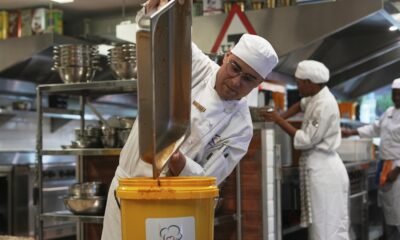
 Lifestyle5 days ago
Lifestyle5 days agoSouth African cooks aim to stir up 67,000 liters of soup to fight hunger on Mandela Day
-

 Asia5 days ago
Asia5 days agoForced from Bhutan, deported by the US: these stateless Himalayan people are in a unique limbo
-

 Africa4 days ago
Africa4 days agoAtlas Lionesses roar into Afcon semi-finals, sparking celebrations in Rabat
-

 Europe4 days ago
Europe4 days agoL’Etape du Tour: How amateurs measure themselves up to pros on one of the world’s toughest stages
-

 Sports3 days ago
Sports3 days agoUnrelenting Scottie Scheffler leaves Open field in his wake. Can anyone catch him?
-
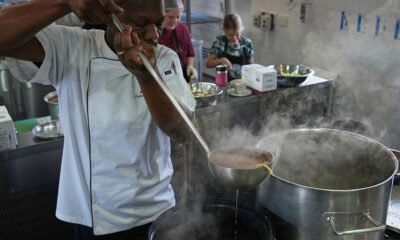
 Africa4 days ago
Africa4 days agoCooks spice things up for soup challenge as South Africa marks Mandela Day
-

 Africa4 days ago
Africa4 days agoRwandan opposition leader Victoire Ingabire denied bail
-

 Asia2 days ago
Asia2 days agoA couple were accused of having an ‘illicit’ relationship. Their community allegedly shot them dead




